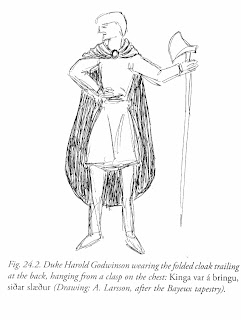sat húsgumi / ok sneri streng / álm of bendi / örvar skepti / en húskona / hugði at örmum / strauk of ripti / sterti ermar / keisti fald / kinga var á bringu / siðar slæður / serk bláfánAccording to Larsson, the above passage is typically translated as follows:


The master of the house sat
and twined a bowstring,
arched a bow of elm,
set shafts to arrows,
while the mistress of the house
studied her arms,
stroked the fine linen,
tightened the sleeves
High curved her headdress,
a coin-brooch was on her bosom,
a trailing robe she wore
a bodice blue-dyed.
The black-and-white photograph on the upper left is a proposed recreation by Larsson showing a warrior as she believes the Rigsþula depicts him; with fabric bands around his forearms and calves, wearing armor. The sketch on the upper right is also by Larsson, and is a redrawing of a figure from the Bayeux Tapestry, wearing armor over an "imperial cloak" which is fastened with a brooch positioned on the center of his bosom.
Larsson's theory, simply put, is that the common translations of Rigsþula are wrong because they assume that the passage in question refers to a woman's clothing. She thinks that the passage actually describes the clothing of a warrior, whose wife is assisting him to dress. Thus, she maintains that the correct translation is more like this:

The master of the house sat
and twined a bowstring,
with flexible elm wood
he set shafts to arrows,
The mistress of the house
was occupied with his arms,
with strips of ribbed cloth
she strengthened his sleeves.
She folded an imperial cloak
from the clasp on his chest,
and shaped a long trail
over his blue-shining armour.
I might have dismissed Larsson's theory out of hand, except for my awareness of reconstructions from the Baltic that show people wearing both leg wraps and arm wraps. A reconstruction drawing of such a costume from the Latvijas PSR Arheologija (and located for me by Santa Jansone on the Yahoo baltic_garb mailing list; thanks!) appears on the lower left. This Latvian warrior is dressed like Larsson's idea of a warrior from the Rigsþula, with bronze-ornamented arm wraps and (in this drawing) plain leg wraps. He is also wearing an "imperial cloak," fastened with a brooch on his chest, over his "blue-shining" armor. Apparently the Baltic habit of ornamenting clothing with large amounts of bronze preserved enough of such wraps that they are known to archaeologists. But that doesn't mean that wraps without bronze ornamentation weren't worn elsewhere in Scandinavia, as Larsson now suggests.
Perhaps Larsson is on to something here. I can't say for sure, since I don't know anything about Old Norse, and thus have no basis for questioning her proposed translation of Rigsþula. I do note that the Baltic garments Larsson's description most resembles are post-Viking Age, which may support the theory that the clothing references in the sagas are to clothing that was commonly worn at the time the saga were written down, i.e., the 12th or 13th centuries CE, not during the Viking age.
The situation depicted in Larsson's translation seems to be unrealistic - how can one assist a man to dress while he is busy with making arrows?
ReplyDeleteThe situation depicted in Larsson's translation seems to be unrealistic - how can one assist a man to dress while he is busy with making arrows?
ReplyDeleteThat's a good question. Part of my frustration comes from the fact that it's hard to tell what actions are being done at the same time and what actions are being done one after the other. Is it clear that attention is being paid to the "arms" at the same time that the warrior is making arrows and twining his bowstring? Or does the attention to the "arms" come after he's finished with the arrows?
Or, does "arms" refer to the arrows themselves? "Arms" also means weapons in English. I just don't know enough about Norse, let alone Old Norse, to answer any of those questions. But the fact that at least one northern culture did use arm wraps makes Larsson's theory interesting.
The first issue that leaps into my head, is that making the entire verse about the man goes against the usual pattern in the verses, of describing the man and then the woman. (At least, how they are traditionally translated.)
ReplyDelete(Especially since Ríg can be interpreted as wandering the world and fathering children with the described women. It makes some sense that there would be a description of them, instead of focusing on how amazing Faðir is.)
The line 'hugði at örmum' probably does deal with the human sort of arm, not the weapon sort.
Örmum is an irregular verbal form of armr, which is a homonym, meaning 'arm/wing' of a thing with a hand at the end, or the edge of something like an army or sea, _or_ a 'wretched' person or thing.
There doesn't seem to be the same weapon homonym of 'arms' as in English, though.
The first issue that leaps into my head, is that making the entire verse about the man goes against the usual pattern in the verses, of describing the man and then the woman. (At least, how they are traditionally translated.)
ReplyDeleteI think that's part of the assumptions Larsson means to question. However, she may need to find exceptions to the "first the man and then the woman" pattern you describe to further support it. If that pattern holds true in other sagas, there may be no good reason for it to break in the Rigsþula and nowhere else.
There doesn't seem to be the same weapon homonym of 'arms' as in English, though.
That's interesting to know; thanks.
However, I note generally that the difference between the standard translations and Larsson's proposed translation about the "arms" is not human vs. weaponry but the gender of the arms involved.